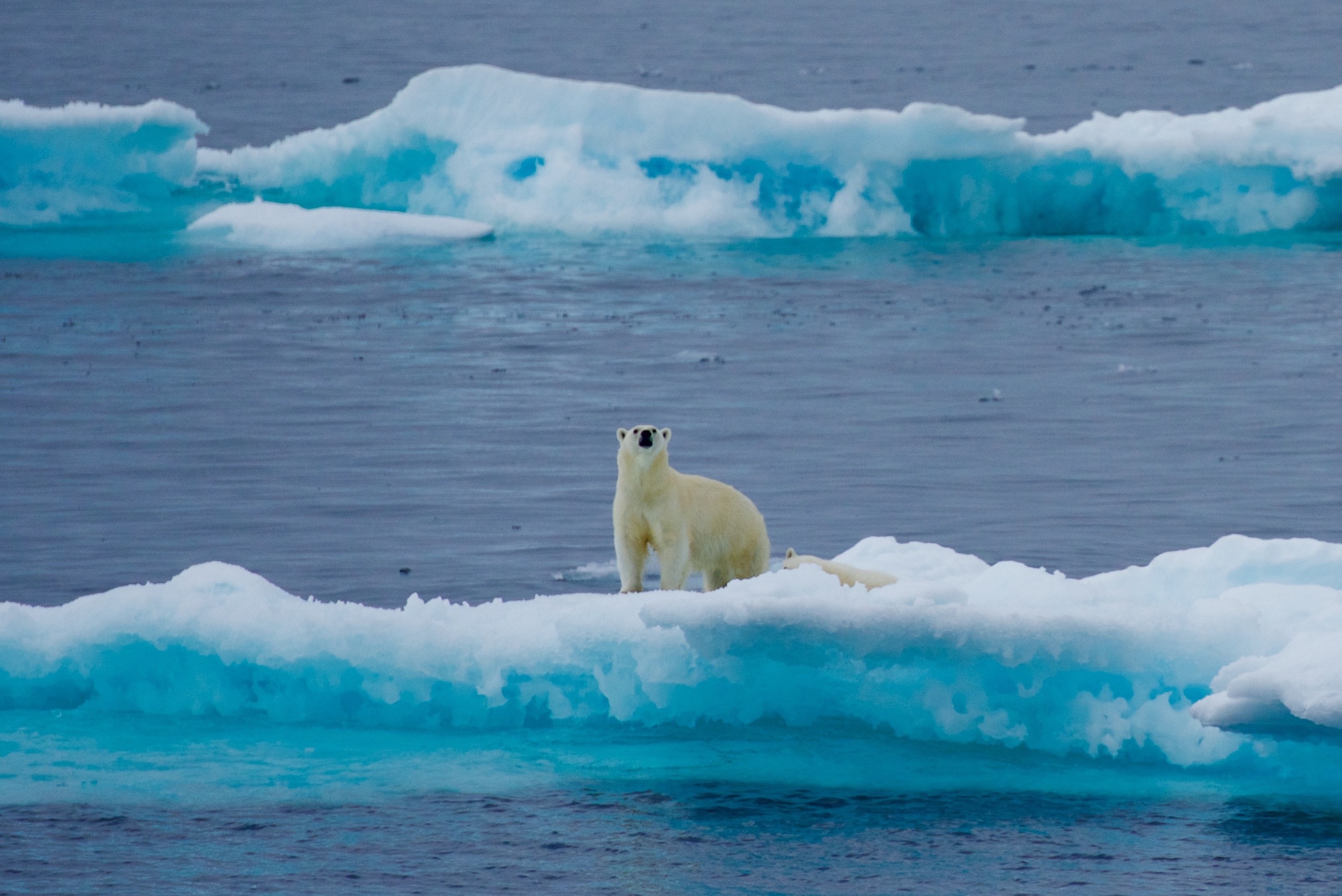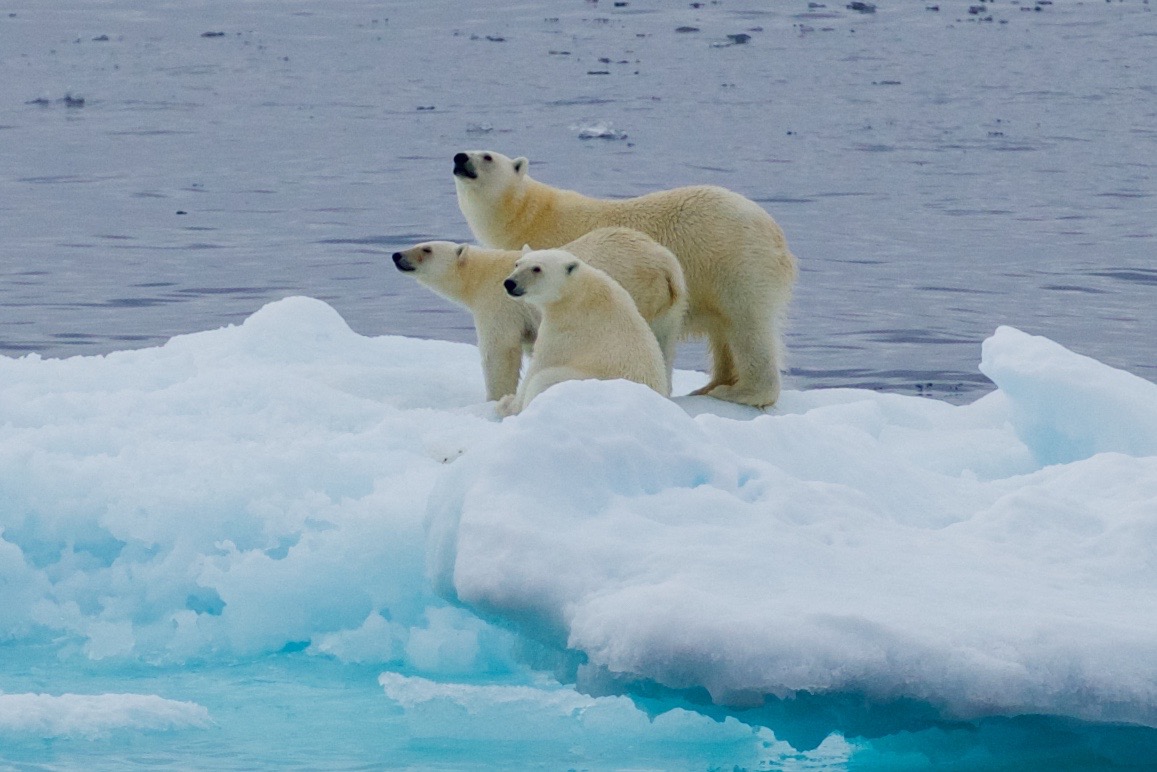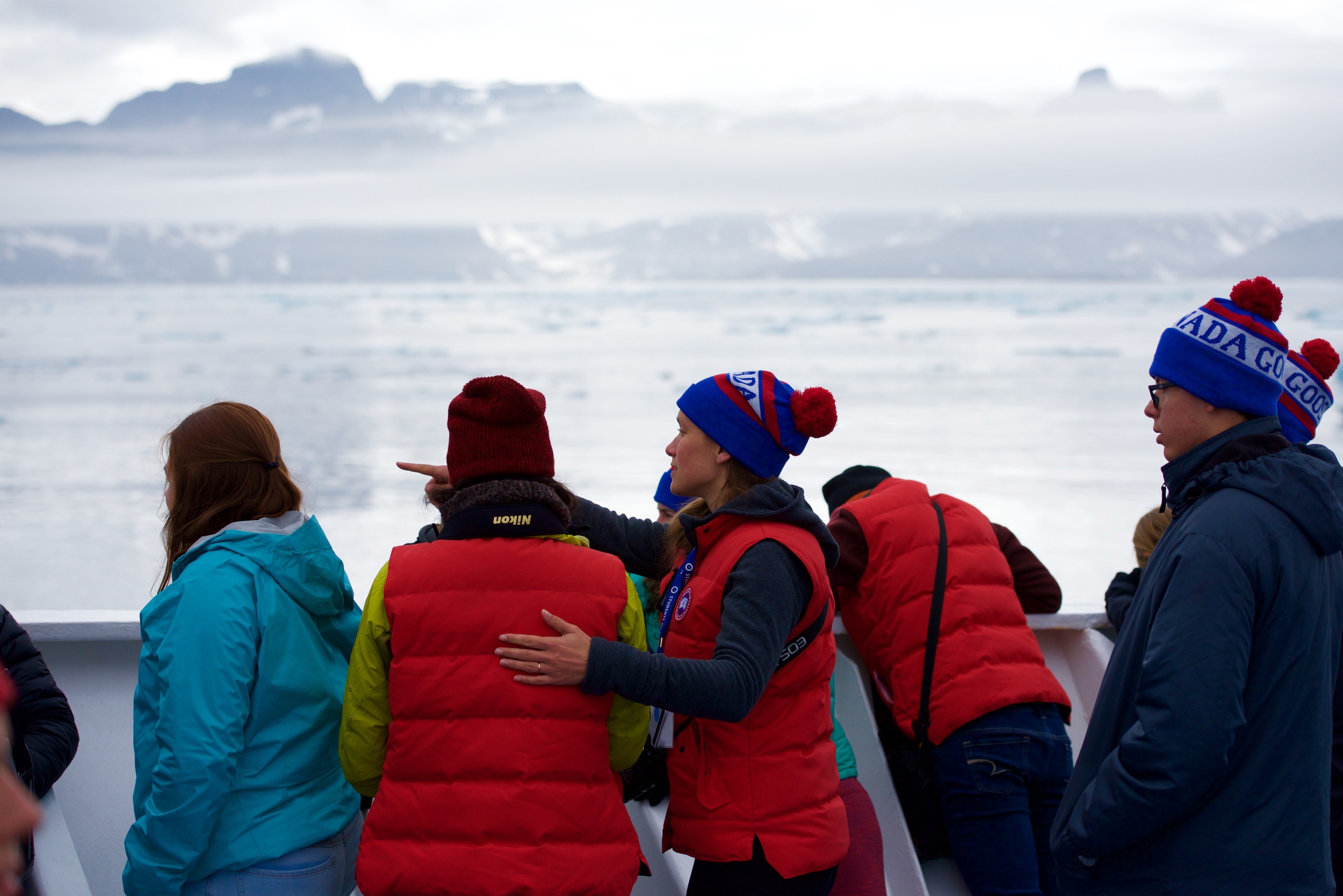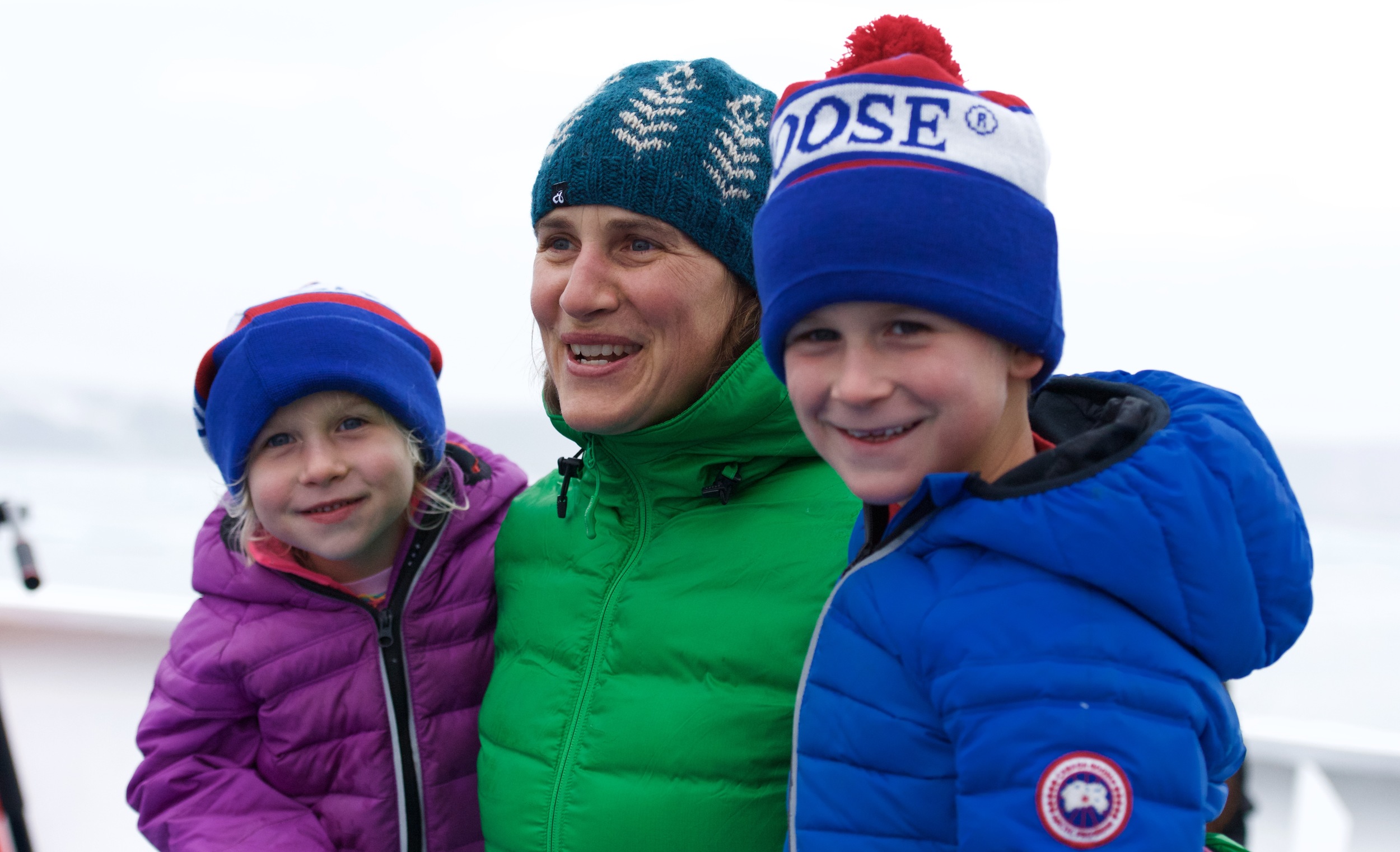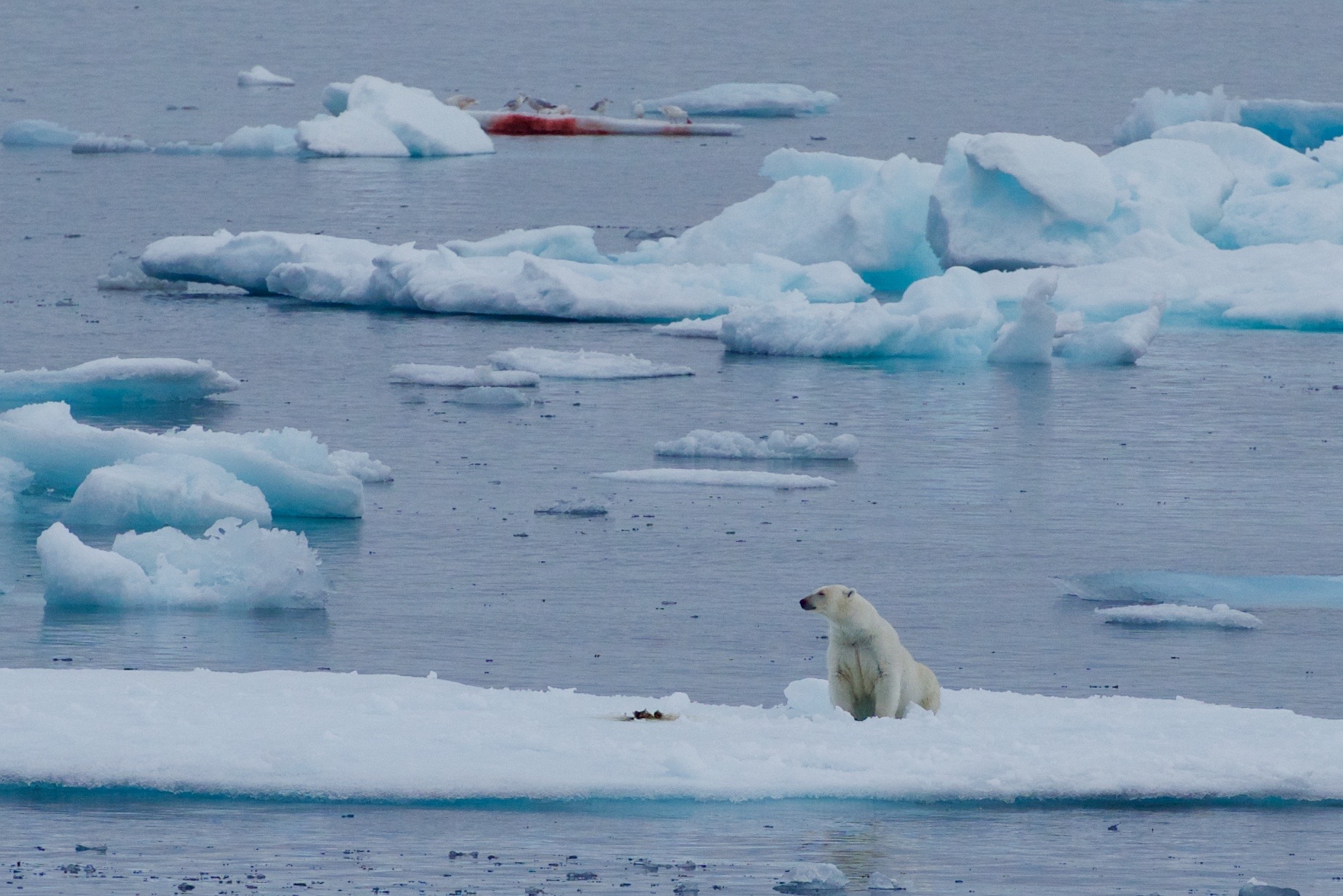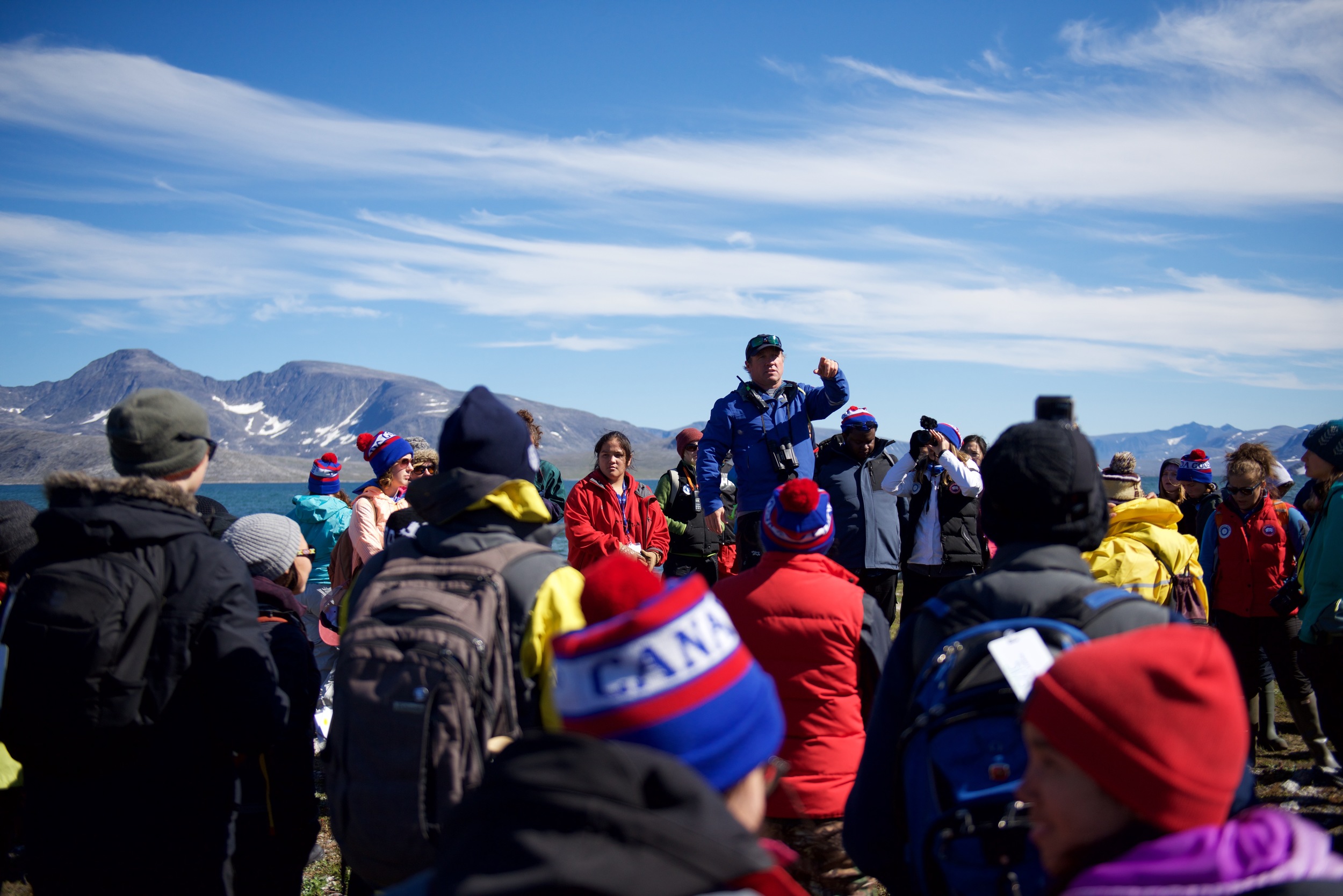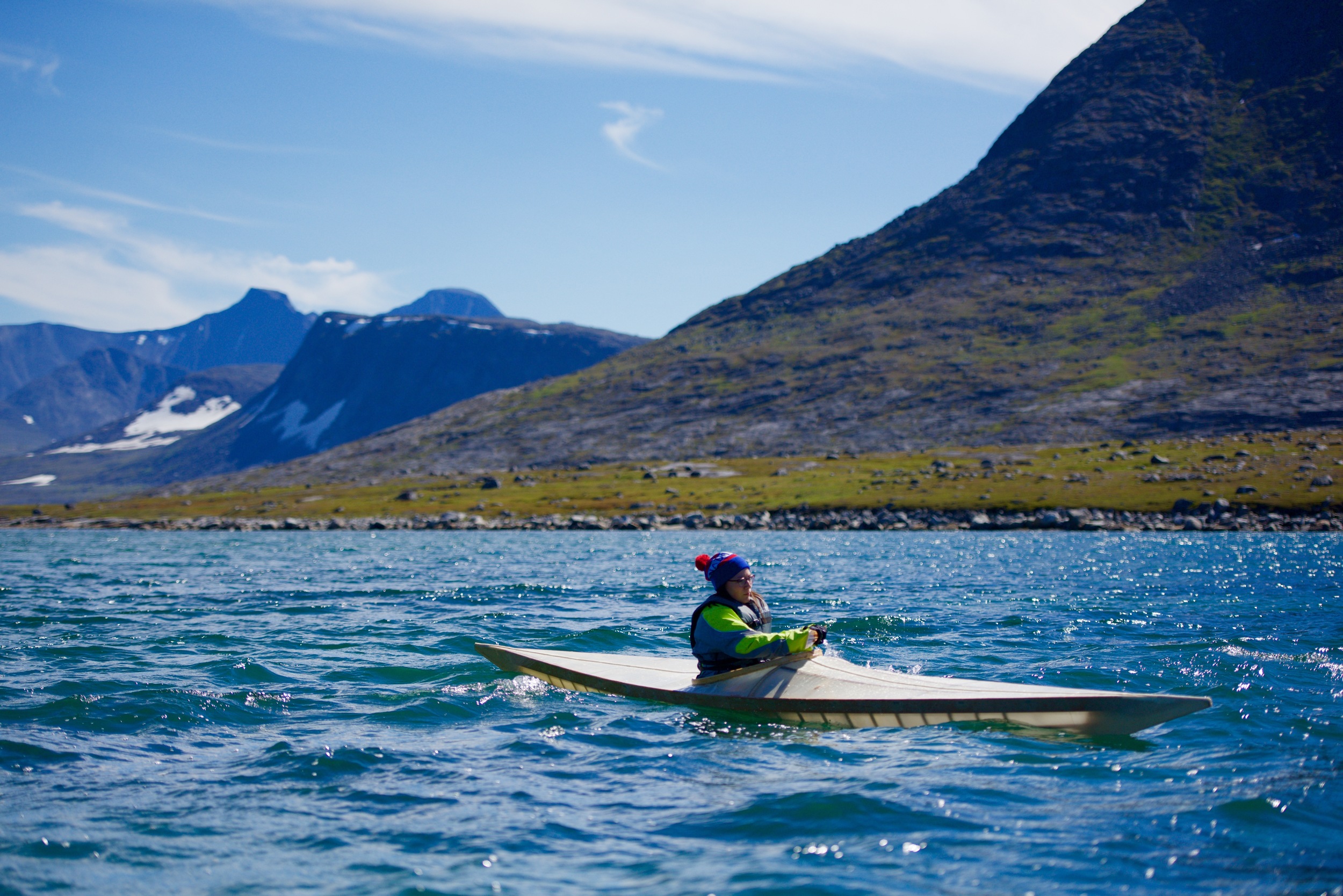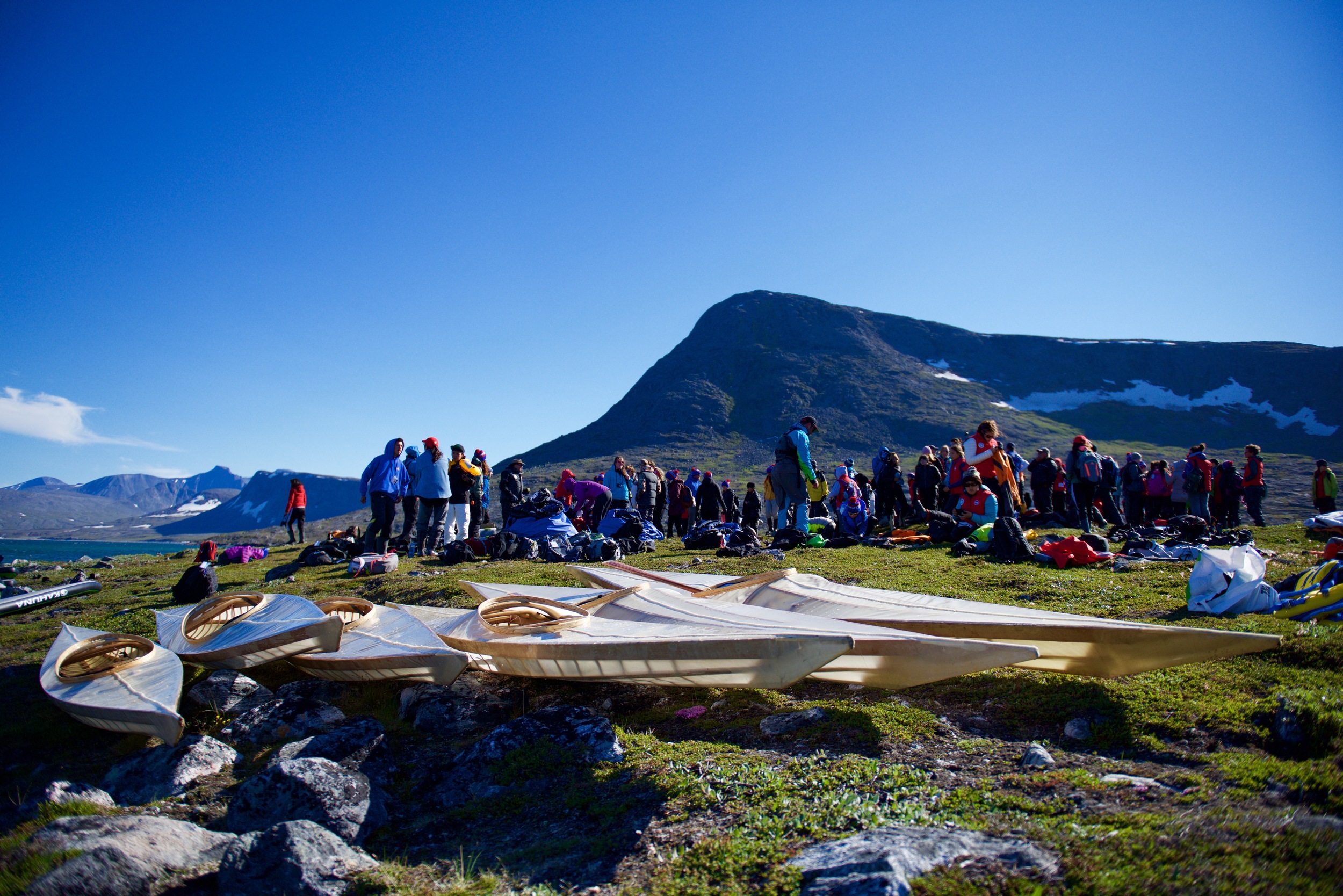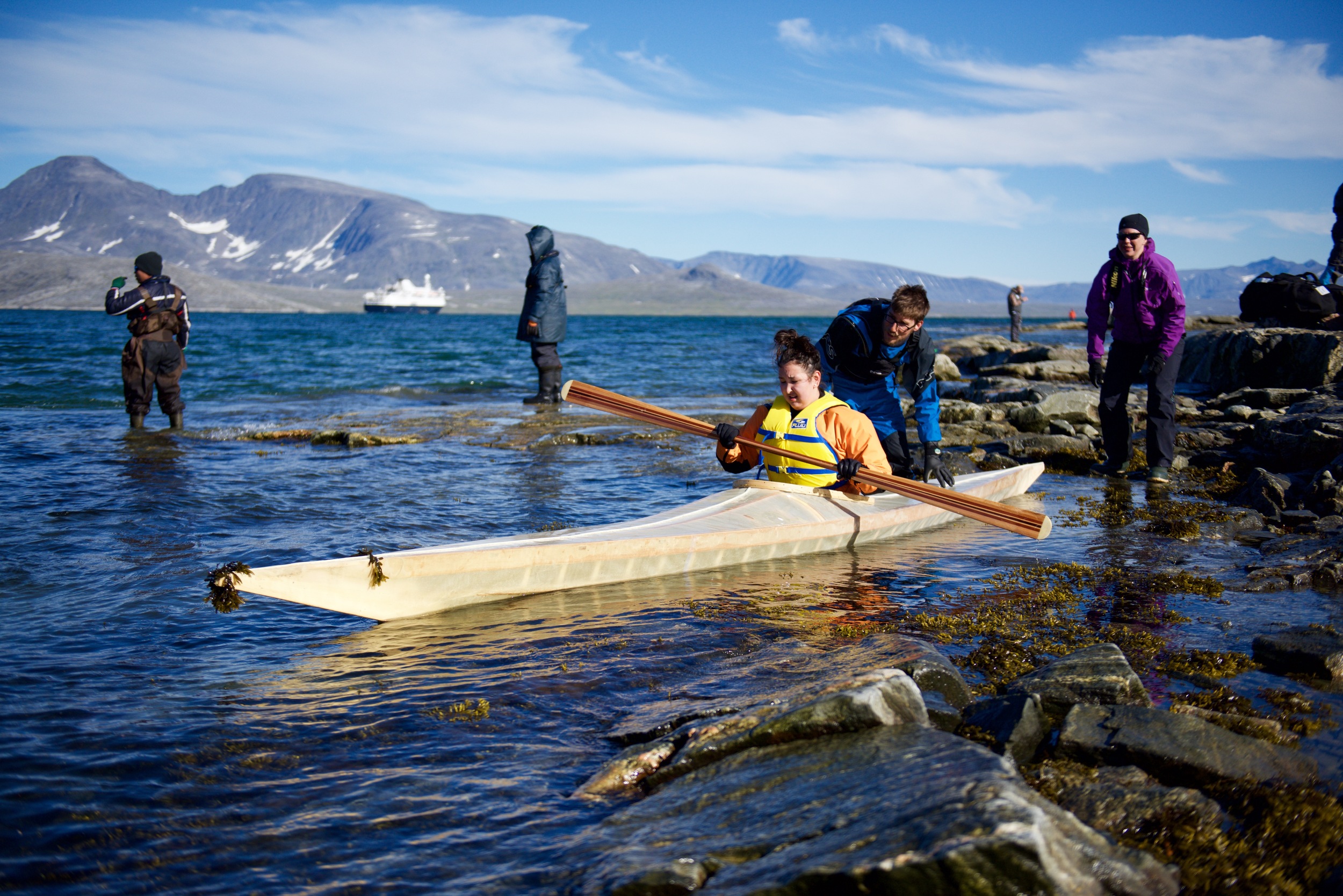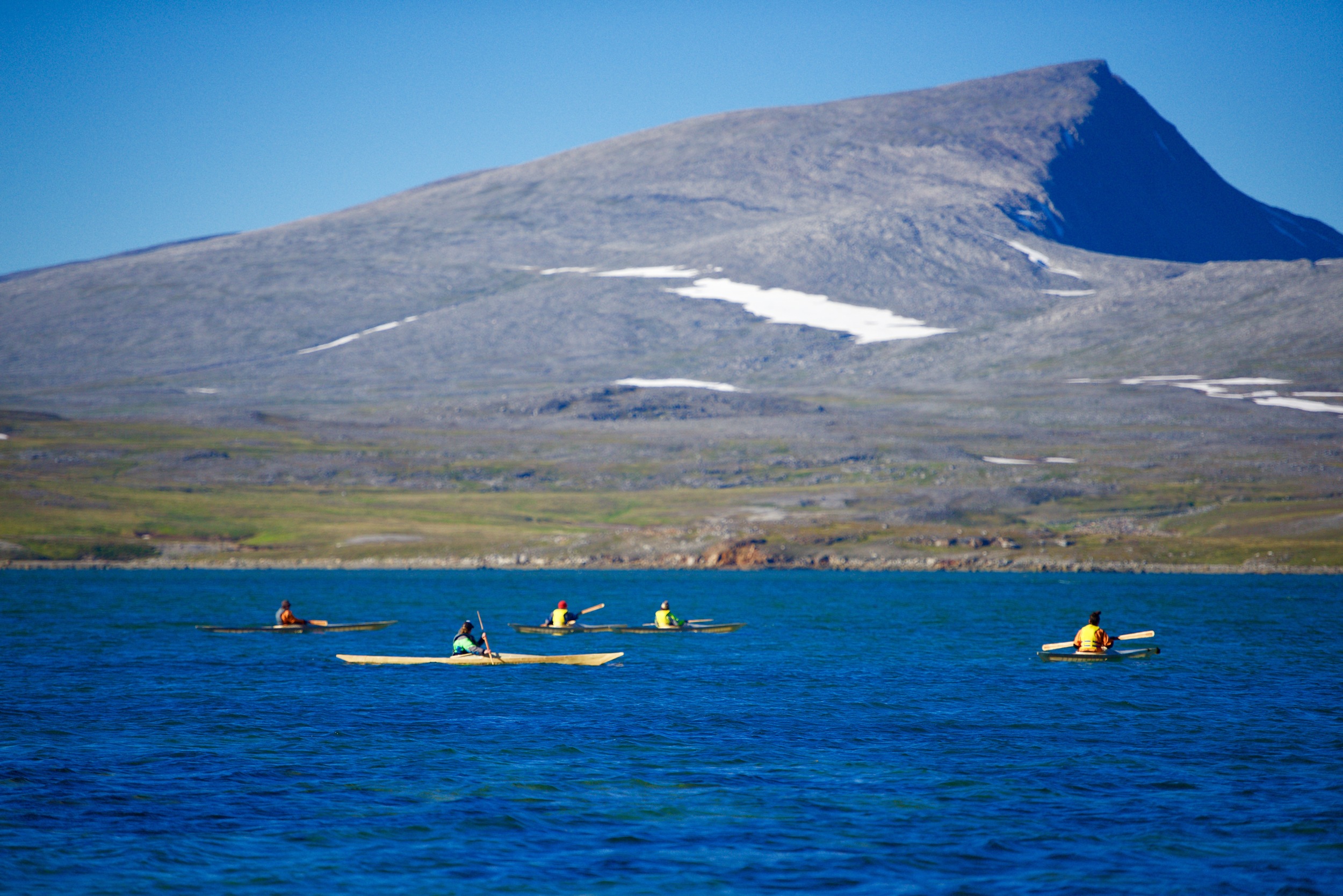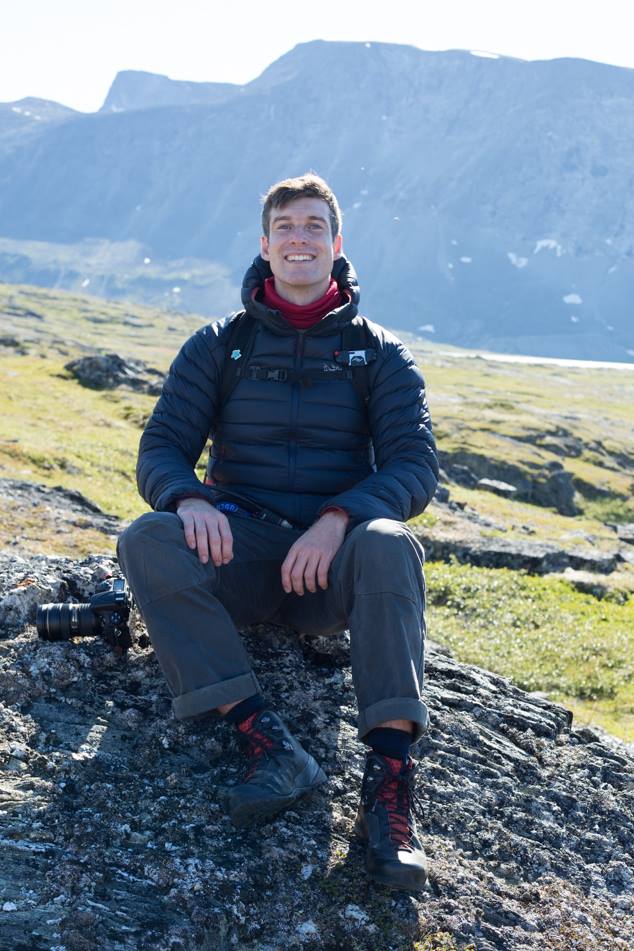Hi friends!
I'm fresh from an expedition to the Torngat Mountains and western Greenland, working as an expedition physician with Students On Ice. I've shared the last three weeks with the most amazing family I've ever worked with - some 120 students from across the North and the world, and a team of 80 educators, including glaciologists, climatologists, botanists, ichthyologists, anthropologists, diplomats, Inuit elders and youth, and some of the world's most brilliant explorers.
Below, I'm sharing daily excerpts from my journals: memories of exploring fjords, calving glaciers, and Inuit communities; watching polar bears, walrus, seals, fish, microscopic critters and humpback whales; participating in the launch of the the National Inuit Suicide Prevention Strategy in Hebron, Labrador; paddling handmade Inuit qajaq's in corners of northern Labrador where they haven't been seen in 150 years, and finding qajaq's old and new in Greenland, home to an awesome resurgence in Inuit qajaq traditions.
Join me on a remarkable adventure across our Arctic home, with videos, photos, and stories below.
In the expedition spirit,
Andrew
Day 1: Ottawa, Canada.
It's not everyday the Prime Minister of Canada, Justin Trudeau, drops by to wish you well on your Arctic Expedition. An auspicious start!
Over the next few weeks, I'll be sharing some of my favourite stories and photos from our Students on Ice expedition to the Torngat Mountains, Baffin, and Greenland. What better way to start then on International Youth Day?
Expedition Leader Geoff Green is one of the greatest champions for youth I've ever met. The organization he founded, Students on Ice, connects northern youth from across Inuit Nunangat with youth from southern Canada and around the world, creating the most profound opportunities for connection, reconciliation, and change I've ever seen.
It's one thing for a young person to hear about climate change, Inuit relocations, or suicide in Northern communities. It's another thing entirely for a young person to sit beside another youth in Hebron, and hear how their grandparents were forcefully relocated from that same spot just 50 years earlier, to accompany them and wipe tears away during the launch of the National Inuit Suicide Prevention Strategy in that same spot, or to stand at the edge of the greatest glacier in the Northern hemisphere, and watch as it calves icebergs into the North Atlantic, the slow motion of it's retreat suddenly speeding into reality. This is a whole other way of knowing; you feel it in your bones, in your heart and soul; it changes you. What better classroom? What better way to learn?
Summer love. aujaq nalligusuk ᐊᐅᔭᖅ ᓇᓪᓕᒐᓱᒃ We made so much music together on our expedition. This unforgettably fun and beautiful piece was written by Natashia Allakariallak of Iqaluit and Katya Potapov of Toronto, with our wonderful expedition musicians Tim Baker and Ian Tamblyn. #nijjausijaquvagut #ᓂᔾᔭᐅᓯᔭᖁᕙᒍᑦ #wemakemusic
Day 3: Iqaluit, Nunavut
I can still taste the salt sea on my lips from our zodiac race to the ship; Kate and I just unpacked the medical kits and set up the infirmary; my bum's wet; and oh man was it cold out on Frobisher Bay, but we're here!
After a day of twists and turns, dramatic weather in Iqaluit, and a slightly too exciting low level arc below the 380ft cloud ceiling over the tundra, we're here - at sea, aboard the Ocean Endeavour.
It's already hard to imagine the heat we left behind at the University of Ottawa and the Museum of Nature. We filled the day playing icebreakers, connecting, learning Inuktitut, climbing trees (I'm a bad influence!), and then, a last minute race to the airport, uncertainty right until we stood on the edge of the ocean, hearing that our second flight had landed. Every part of being where we are tastes a little sweeter knowing we were so close to having it not happen.
We're so lucky to be here, and we know it.
Now, we're outward bound from Baffin Island, heading to the Torngats and north to Greenland. From this point on I'm a physician at sea, helping to keep a wildly inspiring team of 200 students, staff, and sailors safe in our beautiful and unforgiving Arctic home.
Atii, anijuq, ilaujunnaqtugut; ᐊᑏ ᐊᓂᔪᖅ, ᐃᓚᐅᔪᓐᓇᖅᑐᒍᑦ!
Day 4: Frobisher Bay, Nunavut
Our first day at sea, and already we woke up to a large herd of walrus swimming alongside the ship, seals popping up around us, and, playing in the flow edge that had altered our course, nine polar bears hunting seals amongst the ice. Just as beautiful - seeing people discovering these powerful animals for the first time. #nanuq
Day 5: Eclipse Channel, Nunatsiavut
This morning we sailed into Eclipse Channel, in the far northern reaches of the Torngat Mountains.
After exploring a nearby river, we made our first landing and started workshops out on the land - with plant dude Roger teaching tundra botany, Annie Petaulassie teaching sewing, explorer Dr. Fred Roots investigating our surrounding geology, young Fletcher fishing for arctic char, and Eric Mcnair-Landry and Genevieve Cote launching traditional, handmade Inuit qajaqs. Seeing Nunatsiavimmiut youth paddle Eclipse Channel in handmade Inuit qajaqs was one of the most moving experiences of my life.
Here's why:
This spot, North Aulatsivik Island and Eclipse Channel to its west, was one of the last documented camps of what Moravian missionaries called "heathen Inuit", people who resisted settlement and continued to practice a sovereign, Inuit way of life into the late 19th century. I think our Expedition may have been the very first to bring traditional Inuit qajaqs back to Eclipse Channel and North Autlatsivik Island in the 150 years since sovereign Inuit last paddled here.
Inuit and qalunaat youth get ready to explore Eclipse Channel in handmade Inuit qajaqs. I think this might be the first time in 150 years that Inuit have paddled handmade Inuit qajaqs in the northern reaches of the Torngat Mountains. #ᖅᔭᖅ #qajaq #qisforqajaq #makinghistory Students on Ice
Amazingly, I think we also may have launched them from the very spot where Inuit qajaqs were last launched. The southern tip of Eclipse Channel is home to the remains of seven sod homes, but it was "westward to the mouth of a bold snow creek which dashed rapidly into the salt water inlet" where on 20 July 1860, almost 155 years ago to the day, the US Eclipse Expedition (after whom the Channel is named) documented an Inuit winter camp on what I think might be the very spot where we landed on our 2016 Students on Ice Arctic Expedition:
"we sailed westward to the mouth of a bold snow creek which dashed rapidly into the salt water inlet. Here we landed. The first thing we saw on the beach was what appeared to be a dead young seal. Kicking it over, we saw that it was something sewed up. One of the sailors split it open with his knife, which its contents were discovered to be an Esquimaux sealskin shirt and a well worn very short pair of trousers of the same material. Not far off was seen one of the stone huts they build for killing seal, and while we were yet speculating on the fate of the owner of the bundle which was evidently washed up, we came upon an Esquimaux hut, the first we have seen" (Lieber, n.d., in Loring, 1980).
What a perfect accent to a genuinely historic moment: the return of Inuit qajaqs to the northern reaches of the Torngats!
Annie Petaulassie teaches Inuit and qaluunaat youth how to make crafts from the land, at Eclipse Channel in the northern Torngats: "I was brought up in a camp until I had to go to school, I have some knowledge of traditional life. I like to pass on our Inuktitut language, traditional songs, and our history to younger generations."
With 33 years experience in teaching, Annie integrates Inuktitut in all subjects, from kindergarten to the Nunavut Sivuniksavut program. She's celebrated for her skills in sewing, beading, quilting, crocheting, embroidery, and making mittens, slippers, bags, hangings, parkas, and other useful and beautiful things. #teacher #ilisaiji #ᐃᓕᓴᐃᔨ
Day 6: Ramah Bay/Nullatatok + Nachvak Fjord, Nunatsiavut.
This morning we sailed into a place I've heard about my whole life, pulling qajaqs and zodiacs ashore to explore one of the most remarkable archeologic sites in the circumpolar world.
People have lived here for a long time. In August 1868, Moravian missionaries described a funny episode that contrasts the fitness of sailing and qajaqing on this wild coast: “Some Eskimoes whom we had met at Saeglek came to see us, as we slowly continued our voyage up the coast; near Nullatatok we could discern the smoke of their huts and their skin-boat…In spite of favourable wind our progress was very slow, owing to the strong current in a southerly direction, and we had to tow our little craft, assisted by some natives, who came on board with their kayaks."
The beach is full of smooth stones, including ramah chert: a semi-translucent, and fiercely sharp stone used as early as 7,500 years ago to make precision tools traded as far north as Greenland and south to New England. The only known source of this rare stone starts just over that first mountain, rising 600 ft from the sea, a distinct vein running some 30km between Nachvak and Saglek Fjords.
Just meters from the water is a line of green, grassy mounds - the well-preserved remains of Inuit sod homes, and the stone foundations of the house the Moravians built alongside the Inuit: "As Eskimos are by far the larger portion of the year o n the coast, it is very desirable that the new station should be at no great distance from the shore…all the information I could obtain points to Nullatatok Bay as a site for a station, preferably to the spot where our house now stands.” Exploring the shoreline, we could found the remains from the settlement - tools, the door of an old wood stove, and old graves.
Just being in this place is incredibly moving. It’s beautiful to share some of this knowledge with youth exploring it for the first time, to trade eyes for a few moments and catch each others wonder.
Along the shore, near a waterfall, we found a natural amphitheatre made of stone. I brought my cello up here and joined David Serkoak from Arviat, Miki Jacobsen from Sisimiut/Nuuk, and Tim Baker from St. John's, who played a song he calls "Spirits." Our friends told us we looked and sounded great, but there's no way their view was better than ours: an incredible group of people, young and old, from every corner of the north and beyond, and the sea and a wall of cloud perfectly surfing up the mountain on the other side of the bay. What a dream.
As we sailed into Nachvak Fjord, I stood on deck with Boonie and Eli Merkuratsuk, friends I've shared seasons and stories with in Goose Bay, Nain, and the Torngats.
Boonie and Eli were glowing, pointing out places where they'd camped, fished, and hunted with their family growing up. For the Merkuratsuks, this is home. Seeing Nachvak Fjord through their eyes is to discover intimately human stories in one of the wildest places on earth.
Ilinniajuk takunnagiamik. ᐃᓕᓐᓂᐊᔪᒃ ᑕᑯᓐᓇᒋᐊᒥᒃ. #learningtosee
Day 7: Hebron, Nunatsiavut
This morning we sailed into Hebron for the launch of the National Inuit Suicide Prevention Strategy (NISPS).
For Labrador Inuit, Hebron is sacred ground. When we learned the sea ice would alter our course south to the Torngats and Hebron, I was sitting with my young friends from Nain, Makkovik, and Rigolet (Shawna Dicker, Kirsten Dicker, Katrina Ford, Charlie Mae Dyson, Jessica Winters, Michaela Palliser, Robert Jacque) sharing eye contact, feeling the mix of excitement, sadness, and joy that speaks to the importance of this place in our lives.
Beyond the icebergs and islands, the rolling windswept rock hills and valleys are dotted with inuksuit and stone grave sites that speak to hundreds of years of Inuit habitation. The iconic Moravian mission house, crafted with timbers shipped from Germany in 1831 to sedentarize and Christianize the Inuit, still stands here, though it’s now taking on a very different meaning. In 1959, the provincial government declared the community economically unviable, and gathered families into the mission house to tell them that they would be relocated to Makkovik, Nain, and Killinik. They chose the mission house because they knew this was a place where Inuit would not speak back.
Maatalii Okalik, President of the National Inuit Youth Council, speaks to students in Hebron, Nunatsiavut. Mutely shared a message from Natan Obed, president of Inuit Tapirriit Kanatami.
Looking upstream from suicide takes us to places like Hebron, and moments like 1959. Hopelessness, isolation, intoxication, recent loss - these acute crises can feel messy, complicated by mental distress that too often has its aetiology in a combination of acute or toxic stresses in utero and early childhood, themselves informed by intergenerational trauma and the community distress of social inequities like crowded housing, food insecurity, and poor access to services.
All of this is intimately human. My hometown, Makkovik, still has a neighbourhood called “Hebron”, where refugees from the relocation were settled in 1959 along with others like my grandma Nellie, relocated from Nutak, and left to make a new life in an unknown territory, negotiating access to fishing, hunting, and trapping spots in communities where these had already been claimed for generations. I see the acute manifestations of this upstream story every time I see patients in crisis in my emergency room at the Labrador Health Centre.
Walking in Hebron with my dear friend Gary Baikie, we found the beautiful ruins of his family's old house. “Come here,” he gestured to a black and white photo, handing it to me from the wall, “this is my grandmother. This is her house.” The floor is covered in old paint chips, a brush, an axe handle, the debris of everyday life. His daughter, her great granddaughter Caitlyn Baikie walks through the grass beside me to the window, and we go inside.
Caitlyn Baikie, from Nain, stands in her great-grandmothers house in Hebron, Nunatsiavut.
Caitlyn's from Nain, the Arctic Youth and Partnerships manager for Students On Ice. She’s the future. “Whenever I return here I can’t help but think what kind of lifestyle my family and I would have had if we still lived here,” she shares. “We are ready to reconcile with the government, with each other, and with families to move forward to build stronger communities and rebuild aspects of Inuit culture that we once lost."
Gary’s helped build this future. He’s the first Inuit Superintendent of Torngat Mountains National Park, worked on archeological digs in the northern reaches of the park in the 80s, and led the Inuit purchase of the Moravian Mission house. The Moravians initially asked for $1 million, and Gary talked them down to $1. They stipulated that Inuit throat singing and drum dancing never take place in the Mission house - a bizarre request that shows how deep colonial attitudes still run in some circles. Courageously, the first thing Gary and friends did after Inuit reclaimed Hebron was to hold a celebration in the Mission house with Inuit drum dancing and throat singing, welcoming Inuit home.
Wild Labrador weather meant the official launch had to be relocated to to Kuujjuaq ᑰᔾᔪᐊᖅ, Nunavik, and that some of the friends and dignitaries we were expecting were unable to join us, including ITK President Natan Obed, US Ambassador Bruce Heyman, Canada’s Minister of Health Jane Philpott, and from Circumpolar Ambassador and ITK president Mary Simon. But this didn’t stop us from continuing with our own special events to recognize the launch of the NISPS, and I think, allowed for an even more intimate experience for all of us.
Our celebration today really felt like part of this reclamation. Alassua Hanson and Natashia Allakariallak (Iqaluit, NU) throat sang together. David Serkoak (Arviat, NU) and Jonathan Pitseolak (Pond Inlet, NU) drum danced. We again paddled the handmade Inuit qajaqs Eric Mcnair-Landry built, exploring the islands around the community. Maatalii Aneraq Okalik read Natan’s statement from Kuujjuaq, while a gorgeous Inuit sled dog walked freely between the outside and the mission house.
We shared company with Inuit staff from the Nunatsiavut Government and Parks Canada, employed to restore and redefine this as a place of cultural continuity, strongly grounded in Inuit language, culture, and history; a place that supports community cohesion, with all it’s downstream effects, including healthy families and nurturing environments that raise resilient, healthy youth.
A beautiful moment - today, I played cello with Tim Baker in the Mission house, for our expedition family, for survivors of the relocation, for this place. Afterwards, as we watched youth pulling up qajaqs, getting ready to set out again, Jacko D Merkuratsuk smiled and told me the cello had sent shivers down his spine. This meant the world to me - he’s a a bit of a hero to me, like most of the people gathered at Hebron today. Each note was inspired by the most important people in my life, survivors and a new generation building a future I’m so thankful to be a part of.
Playing cello with Hey Rosetta's Tim Baker in the Hebron mission house, to mark the launch of the National Inuit Suicide Prevention Strategy.
Day 8: Saglek Fjord, Nunatsiavut
Today, making house calls meant joining Inuit youth at sea on Saglek Fjord. This was my first time back since Exercise Piulitsinik, our search and rescue exercise with Parks Canada and Joint Task Force Atlantic in the Torngat Mountains last Fall. This time, we surfed stormy waves under dramatic clouds, zipping along the fjord in our zodiacs. A favourite moment: singing Stan Roger's "Northwest Passage" with James Raffan and friends, giving my cello a salt water baptism on the devil's dance floor. There are lots of beautiful moments in medicine, and lots of beautiful ones too.
We spent the day studying tundra botany and archeology, and getting ready to say farewell to Labrador - for me thankfully a very short farewell, until I come back home to Nunatsiavut in the fall. Tonight, we sail north from the Torngats, back across the Hudson Straight and along the eastern edge of Baffin Island towards Greenland.
Group photos are always better with wolf-huskies in them. Students on Ice in Hebron, Nunatsiavut. Qimmiq ᕿᒻᒥᖅ sled dog. Isuraqtujuq ᐃᓱᕋᖅᑐᔪᖅ lead dog in a sled team. Ilagiit ᐃᓚᒌᑦ family. Ilajaakka ᐃᓚᔮᒃᑲ my extended family.


